- This topic has 15 replies, 7 voices, and was last updated 5 years, 2 months ago by
 Eric Watkins.
Eric Watkins.
-
AuthorPosts
-
11 November 2019 at 6:19 pm #574441
 Bill WardParticipant
Bill WardParticipantCaptured another exceptional meteor spectrum last week. Sadly didn’t get the zero order but it must have been bright to produce such a spectacular result. Even better than the the HD Perseid and at least I know what I’m looking at this time…
; – ))

Very distinct line groups make it an easy fit. Also interesting to note that there are no strong near IR atmospheric lines so I can say with some certainty that it had a low Vg.
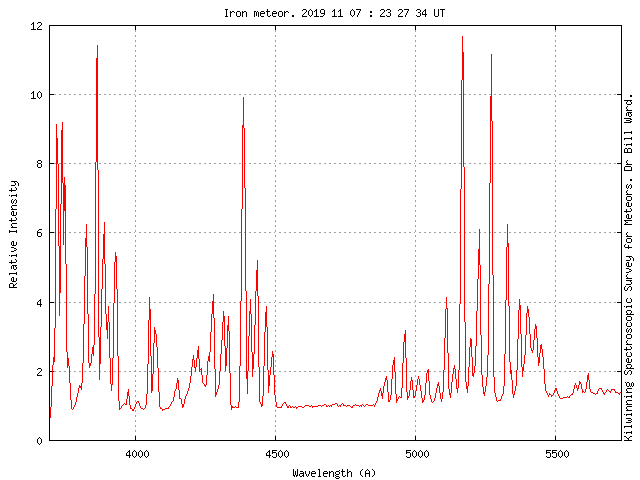
Over 52 major lines plus more fainter lines in the red end of the spectrum (cropped off in this graph).

…and of course my customary colourised version, just gorgeous! As well as being the best Fe meteor spectrum I’ve ever seen (amateur or pro) this one now has the record for the highest resolution meteor spectrum I’ve captured…( so far!)
cheers,
Bill.
PS Edit.
Taken with a ZWO174 mono camera, 25mm f1.3 lens and a 600 lines/mm fused silica substrate UV grating.
11 November 2019 at 6:41 pm #581573 Dr Andrew SmithParticipant
Dr Andrew SmithParticipantI checked the date to see if were a firework! Very clear.
Regards Andrew
11 November 2019 at 7:09 pm #581575 Bill WardParticipant
Bill WardParticipantCould be, LOL!
11 November 2019 at 11:10 pm #581579 Alex PrattParticipant
Alex PrattParticipantHi Bill,
Very nice results.
My Leeds_N camera was clouded out at that time, unfortunately. We’ll see if any other stations were successful and I’ll let you know.
Cheers,
Alex.
12 November 2019 at 11:04 pm #581585 Bill WardParticipant
Bill WardParticipantDear oh Dear, just as well I said “some” certainty….!
I’ve been studying the original image very closely and what I thought might have been faint second order lines appear to be in fact some of the very lines I thought were not present. There is the faintest hint of the 777.4nm O line. So it was “probably” traveling at a lowish Vg!
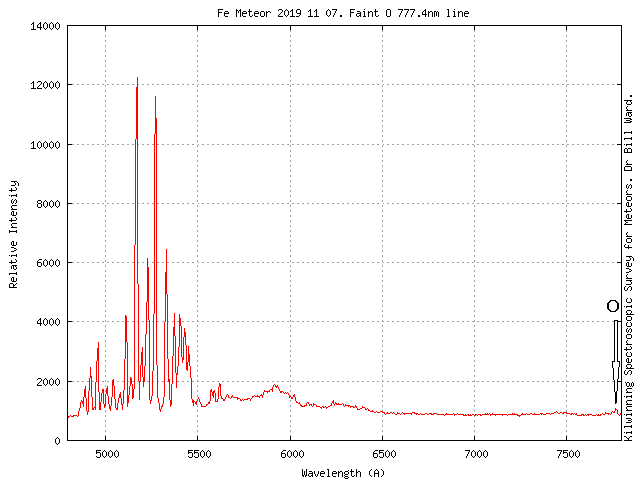
Always be skeptical, LOL!
13 November 2019 at 12:52 am #581586 Derek RobsonParticipant
Derek RobsonParticipantIt’s a beautiful spectrum. It reminds me to use the arc spectrometer I mentioned, obtain some pure iron (or as close as one could get in the iron grades) then obtain a spectrum. It’s an old spectrometer which I need to work out how to fix a camera to record the spectrum over the full wavelength range. I have somewhere, a spectrum of iron and all the major lines already printed in a fold out booklet of several A4 pages long (there are a lot of lines with relative intensities). I will get that copied. It would be nice to discover some exotic elements. But because of the binding energies of the atoms, there is a minimum which occurs around the atomic weight of iron, which I think? means iron is expected to be predominant in abundance (in the nuclear fusion processes of stars), next to cobalt and nickel in the periodic table. I will run cobalt and nickel. Might take me some time because I need a suitable connection to the spectrometer – if it still works?
14 November 2019 at 12:50 am #581592 Bill WardParticipant
Bill WardParticipantHI,
Sounds great! The lines I’ve got from the NIST site indicate the Cobalt and Nickel lines are just out of reach in the UV for my system.
Titanium and Vanadium have been reported in meteor spectra but I’ve never conclusively ID’d those elements. It might be possible now I’ve got to this level of resolution and sensitivity!
Cheers,
Bill.
14 November 2019 at 3:19 am #581593 Derek RobsonParticipant
Derek RobsonParticipantI will add cobalt, nickel, and titanium and vanadium to the list – that is, if I can get the thing to work and add a camera, so a long term project which can be dipped into. The data will build up. I’ll have to check that I have some vanadium and titanium, but if not, I may have a steel with some in. But obviously better to have the pure stuff so I know all the lines come from one element. The amounts in steel are often such that the spectrum will be dominated by iron, and some lines will be difficult to see if they are not as intense. Anyone got any pure vanadium and titanium? I’ll gratefully accept a small chunk, plate. Just has to be a surface area of at least 2 inches.
8 December 2019 at 1:05 am #581738 Bill WardParticipant
Bill WardParticipantHi All,
After tweeting a re-worked spectrum it seems the meteor was captured on an all sky system (Jamie in Lochearnhead). He estimates it was -3.
I decided to re-work the spectrum as I hadn’t really paid much attention to the “thermal tail” between 550nm and 650nm. With the increased resolution I now have I’m more confident about identifying more exotic lines.
It looks like there are some weak lines from Tungsten, Vanadium and Manganese in the mix! I’m pretty sure there’ll be Nickel in the meteoroid but these tend to have their strongest emission in the deeper UV, just beyond my detection limit.
This one really was a cracker and a step forward in observation capability. There are some older observations claiming up to 70 lines in a spectrum but that was based on a spectrum that actually had 27 native lines in the image. The assumption was that the other lines were there because they had emissions at particular wavelengths and were blended together. Using that method and modern data I could claim well over 100 lines here, but I’m not sure if that is really honest science. Anyway, from my element list I count 60 native lines in this spectrum without any assumptions of blending.
cheers,
Bill.
11 December 2019 at 6:15 pm #581768 Mr Jack MartinParticipant
Mr Jack MartinParticipantBill,
Well done, good work.
I have NBS monograph 32 Tables of spectral-line intensities parts 1 + 2, Meggers.
Multiplet tables of astrophysical interest Moore, if this helps with identification.
Regards,
Jack
12 December 2019 at 5:47 pm #581769 Bill WardParticipant
Bill WardParticipantHi,
Thanks and thanks for the kind offer Jack. I’ve got a pdf copy (from the NIST site) of the Multiplet Tables. These “old” works are invaluable even today!
I generally use a selection from the NIST persistent lines catalogue. This has proved an excellent source of data for meteor stuff. Although I don’t think I’ll ever get to needing 0.0001A resolution on my spectra, but you never know LOL! : – )))
cheers,
Bill.
PS. Given I’ve found some other metals I suppose I should change the topic title to “Mostly” iron meteor spectrum… ; – )
12 December 2019 at 6:00 pm #581770 Bill WardParticipant
Bill WardParticipantHi,
I’m not sure what happened to the original picture so here’s another version in case anyone wants a look…
This is the original orientation and full size from HD frame. It also has been contrast stretched to show the faint lines.
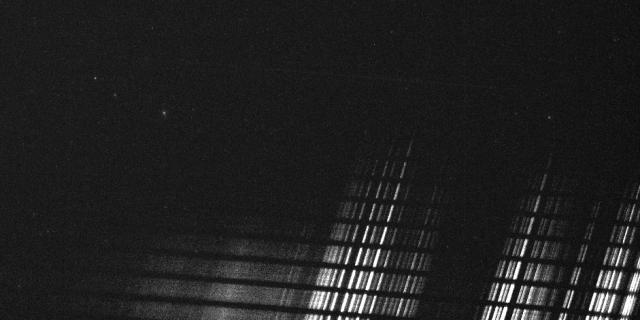
Even though it looks like I only got the start of the meteor, it’s just brilliant!
Cheers,
Bill.
6 October 2020 at 5:57 pm #583213 Bill WardParticipant
Bill WardParticipantHi All,
Yet another extra-ordinary meteor spectrum…, and very similar to the one of this thread!
However, in this case there are some significant differences. There are sodium and magnesium signatures so this one certainly had a more “stoney” feel.

The image actually captures both the first and second orders.
With the extra elements there are lots of lines to identify, graph to follow… ; – )

Cheers,
Bill.
6 October 2020 at 9:49 pm #583214Colin Hall
ParticipantIf it is of any interest I have a chunk of Titanium 6211 that you are welcome to have.
7 October 2020 at 12:36 am #583215 Bill WardParticipant
Bill WardParticipantHi,
Interesting, Colin, there may well be a Ti line or two in the spectrum…
Even at ~0.2nm/pix there are so many lines each could be several elements as many have lines extremely close to each other. I never really envisaged that I’d get results so good this would be a problem! Mmmm, be careful what you wish for…
The blue end…
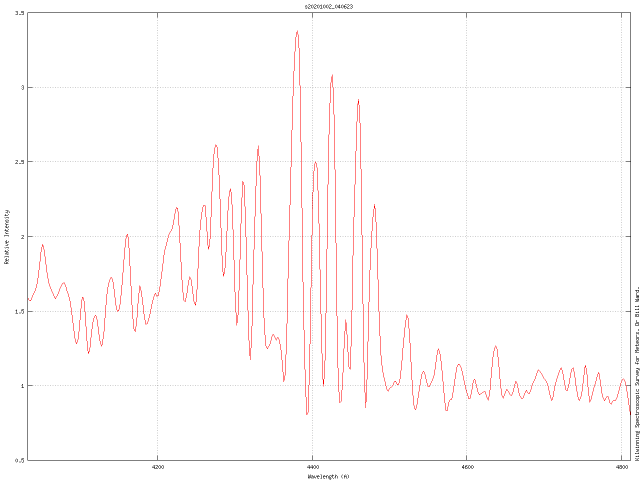
…and the green end…
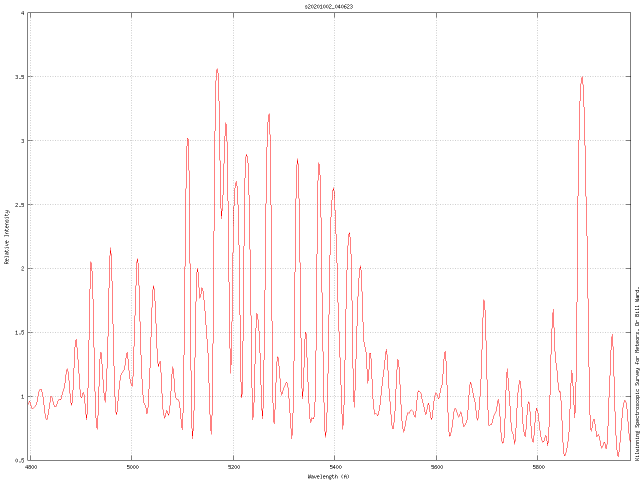
I need a cuppa…
7 October 2020 at 12:49 am #583216 Eric WatkinsParticipant
Eric WatkinsParticipantHi Bill,
excellent results. What set up did you use?
Eric
-
AuthorPosts
- You must be logged in to reply to this topic.
